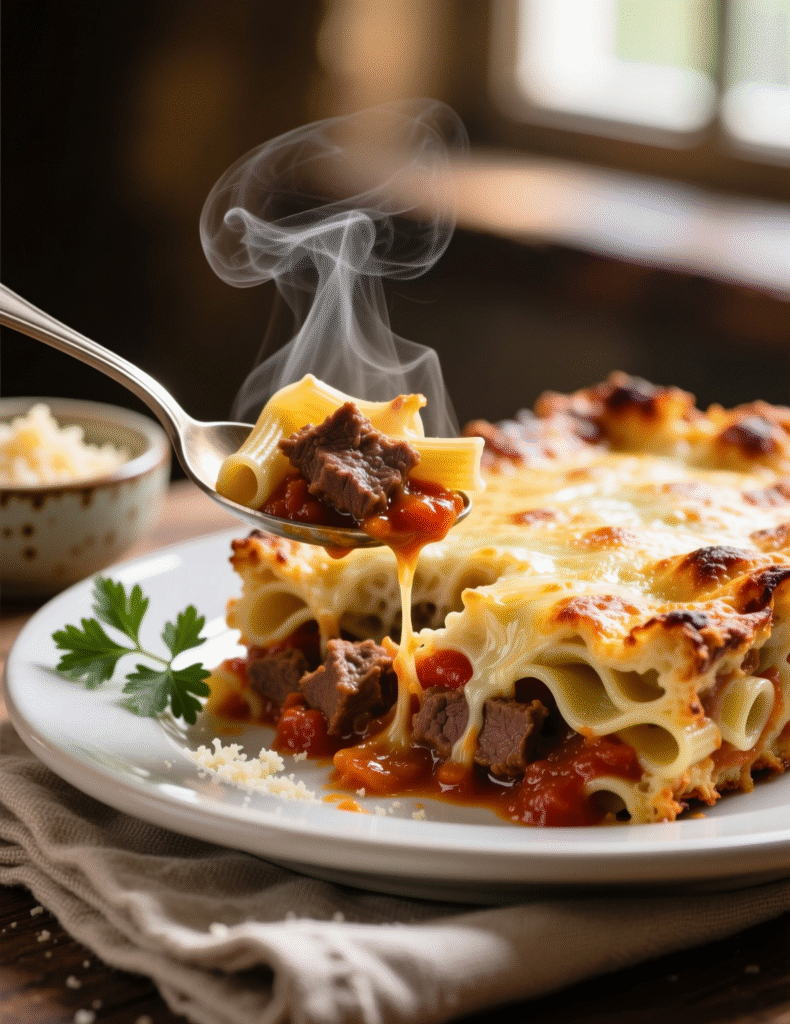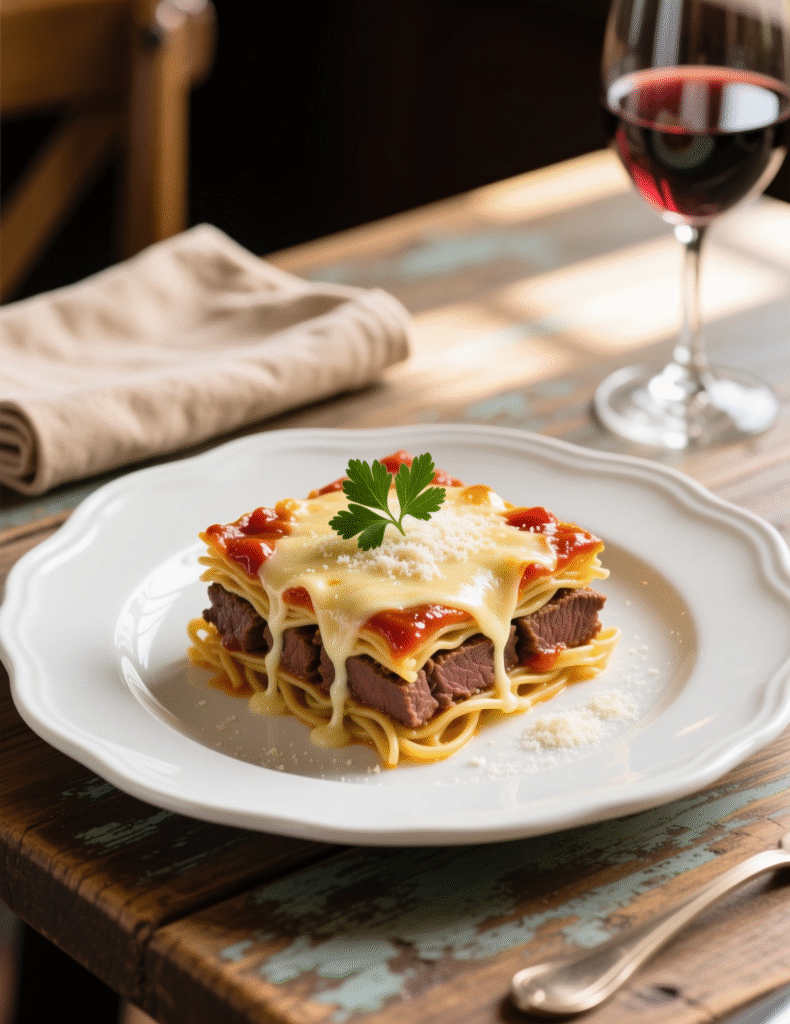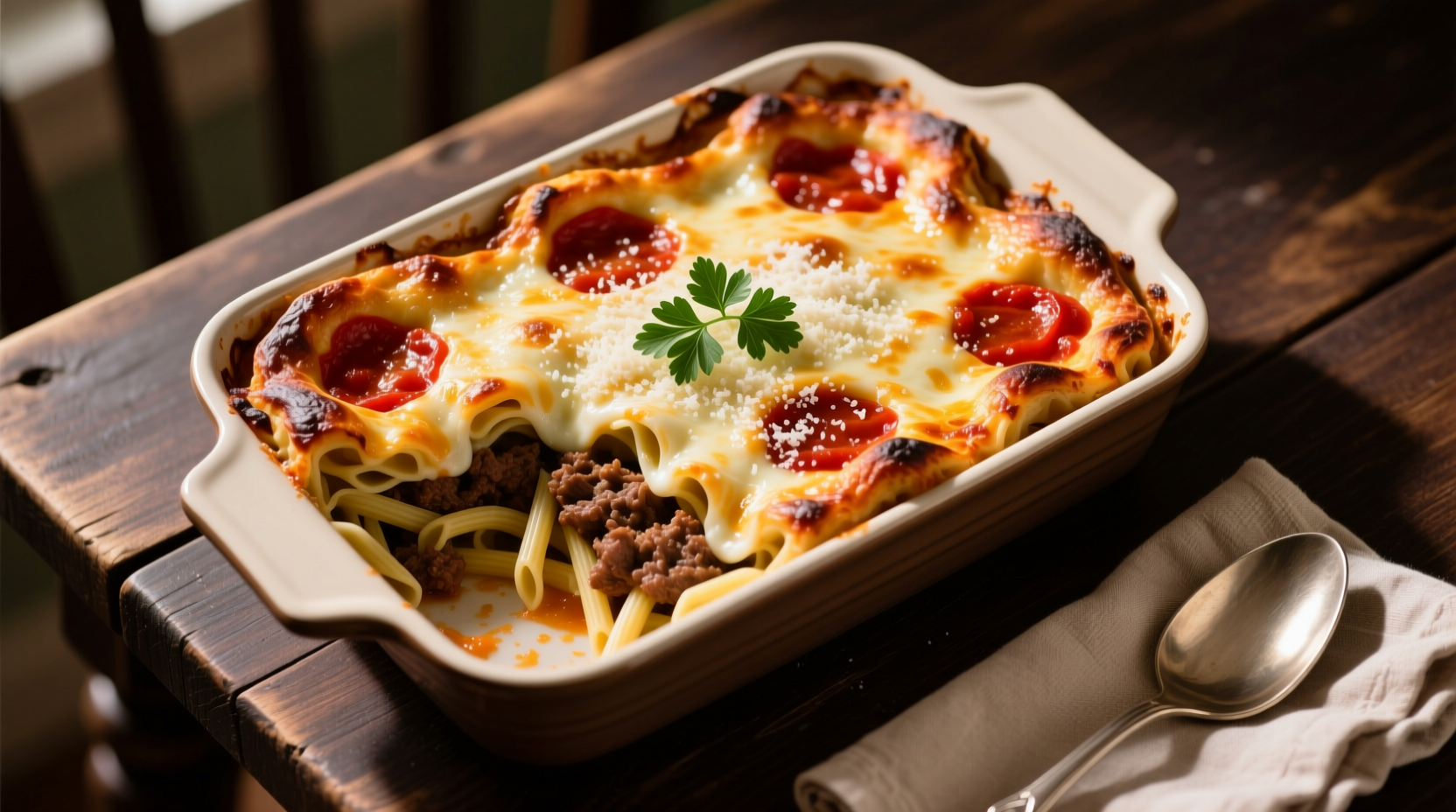Beef Lombardi isn’t just a casserole; it’s a story cooked into layers. You take beef, pasta, tangy tomato, a creamy layer or two, then crown it with cheese, and you’ve got the kind of dish that sneaks into hearts before anyone notices. This recipe for 6 servings is not only about feeding people—it’s about building a table that feels warmer, richer, and maybe a little more grounded than most dinners.
What Exactly Is Beef Lombardi
The origins of Beef Lombardi are hazy at best. It doesn’t carry the centuries-old prestige of Italian classics, nor does it appear in haute cuisine textbooks. Instead, it grew in American kitchens, often church cookbooks and small-town recipe cards of the 1950s and 60s. Think casserole culture—family reunions, potlucks, and freezer meals that could hold steady for weeks.
It’s essentially a layered pasta bake with ground beef, tomatoes, sour cream, noodles, and a blanket of cheese. Some call it a cousin to lasagna, though lasagna would probably scoff at that comparison. Still, Beef Lombardi has one thing that lasagna doesn’t: no rigid rules.
Why Professionals Should Care
Casseroles often get brushed aside in professional kitchens. Too rustic. Too homestyle. But let’s pause. The structure of Beef Lombardi makes it a teaching ground for balancing fat with acid, starch with protein, and layering textures so each bite lands differently.
Chefs who treat this dish seriously discover that it has the flexibility to adapt to clientele. Swap ground chuck for brisket grind? Suddenly, you’ve got depth. Use heritage wheat noodles? The texture shifts. Age the cheese properly instead of using pre-shredded supermarket bags? You’ll taste the difference in melt and stretch.
Ingredients for Beef Lombardi (6 Servings)
- 1 pound ground beef (preferably 80/20 for flavor-fat balance)
- 1 medium onion, diced
- 3 cloves garlic, minced
- 1 can (14.5 oz) diced tomatoes
- 1 can (6 oz) tomato paste
- 1 cup beef broth
- 1 teaspoon dried oregano
- 1 teaspoon dried basil
- ½ teaspoon crushed red pepper flakes (optional, but gives a quiet kick)
- 2 cups egg noodles or wide pasta, cooked al dente
- 1 cup sour cream
- 1 cup cottage cheese (yes, cottage cheese—it lends creaminess with subtle tang)
- 2 cups shredded sharp cheddar cheese
- 2 tablespoons olive oil
- Salt and black pepper to taste
- Fresh parsley for garnish

Step-by-Step Process
Building the Meat Sauce
Start with olive oil shimmering in a heavy skillet. Toss in the onions and cook till translucent, then garlic for a quick 30 seconds. Add the beef, let it brown, but don’t rush—Maillard reaction is your best friend here.
Once browned, stir in tomato paste. Cook it out for a minute; this pulls away raw metallic notes. Add tomatoes, beef broth, oregano, basil, and red pepper flakes. Simmer low for 20 minutes. You’ll want a sauce that clings to noodles, not a watery pool.
The Creamy Middle Layer
Mix sour cream with cottage cheese. Professionals often frown at cottage cheese because it feels old-fashioned. But once baked, it melts into this creamy tang that sour cream alone can’t pull off. This layer acts like a cushion between noodles and meat sauce, softening the bite.
Assembly Matters
Think like an architect. Start with noodles at the bottom of a greased casserole dish. Spread half the beef sauce. Add the sour cream-cottage cheese mix. Then another noodle layer. Finish with the rest of the beef sauce. Top with shredded cheddar like snow falling too heavily.
Bake at 350°F (175°C) for about 30–35 minutes. Cheese should bubble and brown in spots. That’s when you know it’s singing.
Professional Insights
Fat Ratios in Beef
A lean grind, say 90/10, will leave you with a dry sauce no matter how many tomatoes you throw at it. Too fatty, and you’ll swim in grease. An 80/20 grind gives that balance where rendered fat emulsifies into the sauce.
Pasta Choices
Egg noodles are traditional, but a pro might experiment. Pappardelle offers width for layering. Rigatoni stands tall and holds sauce inside. Some chefs even use orzo for a different mouthfeel. Don’t assume the noodle is just filler—it shapes the dish.
Cheese Science
Cheddar is the classic call. Aged cheddar brings sharpness but can break oily if overbaked. Monterey Jack melts smoother, mozzarella gives stretch, and Gruyère adds nutty undertones. Professionals can play with blends, adjusting melt vs. flavor.
A Few Misconceptions
Some folks think Beef Lombardi is too heavy for modern diners. Yet, small-portioned ramekins transform it into elegant comfort. Others say it’s just a “cheap” casserole. But with premium ingredients—grass-fed beef, heirloom tomatoes, artisan noodles—it becomes a fine-dining experience disguised as grandma’s favorite.
Storage and Reheating
Here’s where Beef Lombardi shines for professionals managing prep. It freezes like a dream. Assemble up to the cheese layer, wrap tightly, and freeze. Bake from frozen at 350°F for 50–60 minutes. Restaurants doing family-style takeout often lean on dishes like this.
Reheating? Low and slow. Blast it in a microwave and you’ll kill texture. Better to cover with foil and warm in a 300°F oven till heated through.
Nutritional Angle
Each serving (rough estimate) lands around 480–520 calories, depending on cheese load. Protein comes in at 25–30 grams per serving. It’s rich, yes, but it also satisfies, meaning diners eat less overall. Portion control is where professionals guide healthier habits, not by stripping flavor but by sizing plates right.

Variations for Professionals
- Tex-Mex Lombardi: Swap cheddar for pepper jack, add cumin, and finish with jalapeño slices.
- Mediterranean Lombardi: Use lamb instead of beef, add cinnamon to the sauce, and swap cheddar for feta.
- Vegetarian Lombardi: Replace beef with lentils and mushrooms, build layers the same way, and watch it surprise meat-eaters.
- Fine Dining Twist: Build in individual ramekins, top with béchamel, and brûlée the cheese for crisp sophistication.
Cultural Context
Casseroles like Beef Lombardi represent a time in American history when efficiency mattered. Women in the 60s entered the workforce in greater numbers, yet family dinners still held symbolic importance. A dish that could be assembled ahead, refrigerated, then baked for the family? Revolutionary.
That practicality explains why it endures today. The ability to prepare, freeze, and scale for larger groups makes it invaluable even in professional catering settings.
Why It Resonates Still
Dishes that persist across decades usually do so because they speak to more than the stomach. Beef Lombardi has nostalgia baked in, but it also meets modern kitchens with flexibility. Comfort is a timeless ingredient—chefs who ignore that lose half the dining experience.
Common Mistakes to Avoid
- Overcooking noodles before baking. They’ll turn mush. Always undercook slightly.
- Skimping on seasoning. Cheese and creaminess dull flavors; the sauce must be bold.
- Using pre-shredded cheese. Additives prevent proper melting. Block cheese always wins.
- Baking uncovered too long. This dries layers out. Foil for the first 20 minutes, then uncover for browning.
Conclusion
Beef Lombardi, for 6 servings or 60, is a dish of balance—hearty yet adjustable, humble yet capable of refinement. For professionals, it’s a chance to revisit casserole culture with a sharper eye, applying culinary technique where once there was only convenience.
Approach it not as a “church potluck classic,” but as a canvas for craft. Layer flavors with intention, balance fat with acid, respect textures, and suddenly this humble bake belongs on more than just a family table. It belongs wherever chefs are brave enough to let comfort wear a professional coat.
FAQs
What is Beef Lombardi?
Beef Lombardi is a layered beef, pasta, and cheese casserole often compared to a relaxed version of lasagna.
How many servings does this recipe make?
This recipe is designed to yield 6 hearty servings.
Can I make Beef Lombardi ahead of time?
Yes, you can assemble it, refrigerate overnight, or freeze before baking.
What type of beef works best?
An 80/20 ground beef blend provides the ideal balance of flavor and moisture.
Can I substitute the noodles?
Yes, egg noodles are common, but pappardelle, rigatoni, or even orzo work too.
Is cottage cheese necessary?
It adds creaminess and tang, but you can swap with ricotta if preferred.
How long does it take to bake?
Bake for 30–35 minutes at 350°F until the cheese is bubbly and golden.
Can Beef Lombardi be frozen?
Absolutely, it freezes well and can be baked straight from frozen.
What cheese is best for topping?
Sharp cheddar is traditional, but blends with mozzarella, Gruyère, or Monterey Jack work beautifully.
How do I reheat leftovers?
Reheat in a 300°F oven, covered with foil, to preserve texture and flavor.
Is Beef Lombardi suitable for vegetarians?
Yes, replace beef with lentils, mushrooms, or plant-based crumbles for a vegetarian version.
What makes Beef Lombardi different from lasagna?
It’s less rigid, quicker to assemble, and more adaptable than traditional lasagna.

Mariana is a passionate home cook who creates delicious, easy-to-follow recipes for busy people. From energizing breakfasts to satisfying dinners and indulgent desserts, her dishes are designed to fuel both your body and hustle.
When she’s not in the kitchen, she’s exploring new flavors and dreaming up her next recipe to share with the Foodie Hustle community.

